- Site Tour June 17, 2010
- CCC meeting September 17, 2008 in Lee
- CCC meetings March 26 &27, 2008
- CCC meeting December 5, 2007
- CCC meeting September 19, 2007
- CCC meeting June 13, 2007
- BEAT report on 4/24/2007 CCC meeting
- BEAT report on 3/6/2007 CCC meeting
- Coordinator’s Report on the Meeting of December 14, 2005
- BEAT report on 12/14/2005 CCC meeting
- CCC meeting schedule for 2006
- What is the Citizens Coordinating Council (CCC)?
return to GE & PCB issues page
Site Tour around Pittsfield – June 17, 2010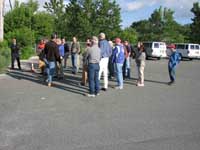 On June 17th we loaded into three large vans for a tour of various sites in Pittsfield that have been a part of the remediation of PCB contamination by General Electirc Company (GE) and the US Environmental Protection Agency (EPA). On June 17th we loaded into three large vans for a tour of various sites in Pittsfield that have been a part of the remediation of PCB contamination by General Electirc Company (GE) and the US Environmental Protection Agency (EPA).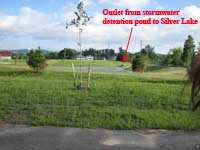 We visited the Pittsfield Economic Development Authority (PEDA) where we heard lots of optimism, but no new businesses actually building anything yet. There has been work on the site by PEDA including a large stormwater retention basin with an overflow to Silver Lake. We were told that most of the water in the basin comes into the site from Pittsfield stormwater system pipes. The outflow is monitored. We visited the Pittsfield Economic Development Authority (PEDA) where we heard lots of optimism, but no new businesses actually building anything yet. There has been work on the site by PEDA including a large stormwater retention basin with an overflow to Silver Lake. We were told that most of the water in the basin comes into the site from Pittsfield stormwater system pipes. The outflow is monitored.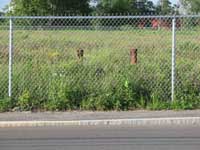 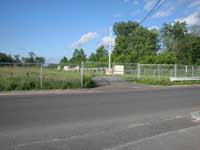 We also visited the “Lyman Street Parking Lot”, now covered with vegetation… and dotted with monitoring wells. This location covers up a highly contaminated lot. GE was not required to remediate even though it abuts the river. There is sheet piling between the lot and the river, and PCB contaminated ground water is pumped out to be treated. We also visited the “Lyman Street Parking Lot”, now covered with vegetation… and dotted with monitoring wells. This location covers up a highly contaminated lot. GE was not required to remediate even though it abuts the river. There is sheet piling between the lot and the river, and PCB contaminated ground water is pumped out to be treated.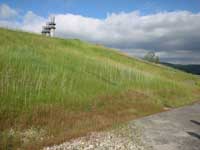 At Hill 78, the low level toxic waste dump built on top of who knows what, we were allowed to go up to the top of the Hill. There is a paved road to the top. From the top you get an interesting view. You look out over Allendale Elemantary School to the north. And you get a new perspective on the gas-fired generating plant to the east. At Hill 78, the low level toxic waste dump built on top of who knows what, we were allowed to go up to the top of the Hill. There is a paved road to the top. From the top you get an interesting view. You look out over Allendale Elemantary School to the north. And you get a new perspective on the gas-fired generating plant to the east.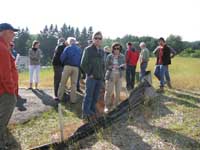 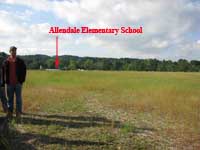 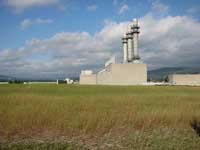 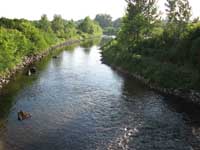 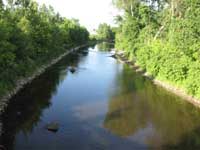 We also took a look at the river from the Lyman Street bridge. Riprap is still visible, but tree growth is impressive. We also took a look at the river from the Lyman Street bridge. Riprap is still visible, but tree growth is impressive. |
||
| Citizen Coordinating Council meetings with GE, EPA, and DEP – 9/17/2008 The draft agenda (pdf) for the September 2008 Citizens Coordinating Council meeting is available.The meeting starts at 5:30 PM, at Lee Middle and High School in Lee MA. The agenda includes Rest of the River, Modifications to the Consent Decree, Silver Lake, action on the West Branch particularly next to Dorothy Amos Park, the NPDES (National Pollution Discharge Elimination System) permit which expired long ago and has been in the process of being re-evaluated for a couple of years now, and an “evaluation” of how the CCC is functioning.For more information on the issue of GE and PCBs in the Housatonic River visit BEAT’s “GE & PCBs” webpages, or the Housatonic River Initiative’s website, or the EPA/GE website. return to top |
||
| Citizen Coordinating Council meetings with GE, EPA, and DEP – 3/26/08 (CT) & 3/27/08 (MA)Draft agendas for each of the March 2008Citizens Coordinating Council meetings in Connecticut and Massachusetts are available.The CT meeting was on March 26, at 6 PM, at Kent Town Hall. The MA meeting was on March 27, at 5:30 PM, at Lee Middle and High School in Lee MA.Both meetings covered the same topic, a presentation on the Corrective Measures Study that General Electric Co. (GE) will complete this month for the Rest of River project.For more information on the issue of GE and PCBs in the Housatonic River visit BEAT’s “GE & PCBs” webpages, or the Housatonic River Initiative’s website, or the EPA/GE website. return to top |
||
| CCC Meeting December 5, 2007The Citizens’ Coordinating Council (CCC) met December 5, 2007 at 5:30 pm at the Berkshire Athenaeum in Pittsfield. BEAT videotaped the meeting to air on Pittsfield Community Television’s Channel 18. The main topic of presentation and discussion was the Silver Lake Capping Pilot Project.The facilitator for the meeting has prepared draft summary (.doc file) of the highlights from the meeting. return to top |
||
The CCC meeting September 19, 2007The Citizens’ Coordinating Council (CCC) met September 19, 2007 at 5:30 pm at the Crowne Plaza in Pittsfield. The facilitator has prepared draft summary (.doc file) of the highlights from the meeting.
Citizens Coordinating Council (CCC) meetings are held with the General Electric Company (GE), the US Environmental Protection Agency (EPA), and Massachusetts Department of Environmental Protection (DEP), and open to the public (although you might not get a chance to ask questions, you usually do get an opportunity toward the end of the meeting). |
||
| CCC meeting June 13, 2007The quarterly full CCC meeting was held June 13 at Cranwell in Lenox, MA. The primary topic was a discussion and presentation, case studies, and discussion of floodplain and river restoration techniques. return to top |
||
BEAT report on 4/24/2007 CCC meeting:On April 24, 2007 the EPA and Mass DEP held an “informal” CCC meeting. Here is BEAT’s summary – corrections are welcome!
|
||
| BEAT report on 3/6/2007 CCC meeting On March 6, 2007, General Electric Company (GE) made a presentation on their Corrective Measures Study (CMS) proposal (341 pages – 17mb – Estimated download time: < 74 minutes @ 33.6kbs) to an audience of about 50 people. The CMS describes the different actions that GE wants to consider taking on the “Rest of the River” – the Housatonic River from the confluence of the east and west branches near Fred Garner Park in Pittsfield to Long Island Sound near Stratford, CT.Perhaps the most disturbing, yet expected, aspect of GE’s CMS is that in every scenario they propose taking NO ACTION (other than a little monitoring) downstream of Rising Pond Dam – NO ACTION in Connecticut. GE pointed out that, according to their data, there is very little contamination in Connecticut. When questioned about other data that showed fish – pike – with 30 parts per million (PPM) of PCBs, GE replied that just three pike were sampled, and two had very low levels of PCBs, just one was high and they consider that an aberration. One of BEAT’s directors points out that another way to look at that is that one third of their samples had 30 ppm and perhaps they should study this further! A lack of data does not mean there is no contamination in Connecticut. It means they haven’t looked. There should be a thorough study of sediment behind all the dams on the Housatonic River downstream of the confluence.Another disturbing aspect of GE’s CMS is their “screening out” of less invasive alternatives. For example in the floodplain, either they will take no action, put up signs telling people not to eat the fish, study the natural recovery – or they will go in and remove all the soil – or cover it over (which is unlikely in that it would decrease flood storage capacity). They screened out in-situ treatments (physical, biological, chemical, or thermal) as not well suited for large areas, or not successfully implemented full scale elsewhere with significant PCB reduction. BEAT is hopeful that GE and EPA might consider new and emerging technologies to test for use in our floodplains.The Housatonic River Initiative‘s hired expert, Dr. Peter de Fur, asked if GE and EPA had considered multi-chemical interactions in looking at what levels of PCBs are “protective” of human health and the environment. The answer was NO.Dr. de Fur said that, having only had a couple of days to review the CMS, which was released February 27, he found it to be “thin” – no consideration of alternative technologies, only consideration of old technology, no comparable study information.Then Dr. de Fur asked is there was “source control”. GE did not appear to answer this question in a direct manner. They pointed to many aspects of “source control” that they are continuing – pump and treat of plumes, they will be remediating the west branch of the river near Dorothy Amos Park, they are studying other areas. What they did not say directly is that NO, there is not yet source control. There is source reduction, to be sure. But there are still PCBs flowing into the river from Unkamet Brook – above the “clean up” in Pittsfield, from Silver Lake, and from every pipe that GE monitors that comes off the old GE site in Pittsfield.Representatives from GE continually referred to clean materials on top of PCB contamination as “recovery”. BEAT pointed out that that is not recovery – it is cover up.One “remedy” presented by GE is “thin-layer capping” – adding a thin layer of sand or similar material over contaminated areas.Natural recovery appears to mean that enough sediment covers up the PCB contamination.It appears that GE is offering two basic alternatives – do nothing – or – destroy all habitat in and around the river. We do not think this is a valid choice.Andrew Madden of the Massachusetts Division of Fish and Wildlife pointed out the proposed alternatives for eroding banks didn’t consider many preferable alternatives. GE proposed: no action, remove/replace, or armor using armor stone and/or mats. Andrew pointed out there are much less habitat destructive ways of dealing with eroding banks.The thirty-day public input period for the Corrective Measures Study Proposal (341 pages – 17mb) will run from March 1st to March 30th. During this time, interested members of the public are invited to submit comments to EPA on the draft document. Comments should be postmarked no later than March 30th and sent to:Susan Svirsky EPA Rest of River Project Manager c/o Weston Solutions 10 Lyman Street Pittsfield MA 01201 re: CMS Comments Comments can also be sent via email to: svirsky.susan@epa.gov or via fax to: 413-442-4447In other CCC news, EPA said that Building 71, the high level toxic waste dump next to Allendale Elementary School is full and has a final cap on it. Hill 78 the low level toxic waste dump looming over the playground at the school, is at 85% capacity and a cap will be installed on at least 1.9 acres of this UNLINED landfill. A sanitary sewer line and stormdrain line that run UNDER Hill 78 will be rerouted. BEAT asked what would happen to the old pipes. They will be capped. We pointed out this is insufficient. These pipes still provide a preferential pathway for liquid to run along the outside of the pipe and make there way to the little stream that then carries the liquid to the Housatonic River. A vertical barrier should be installed – sort of a ring collar – at the end of the pipe. The water currently coming out of this pipe has never been tested for PCBs despite HRI and BEAT’s requests.(see the meeting highlights prepared by the meeting facilitator for this meeting, or for the meeting on March 7th in Connecticut.)return to top | ||
| Coordinator’s Report on the EPA-GE Citizen Coordinating Council Optional Meeting of December 14, 2005HighlightsAllendale SchoolEPA described the results of its soil and air sampling, as follows:Soil sampling for the playground showed no contamination that would make the playground unsafe. Twenty samples were taken; eighteen showed non-detection of PCBs, and two samples showed 0.07 and 0.06 ppm of PCBs. The action level for PCBs in soil is 2 ppm.Three air monitors were placed on the Allendale School playground. Two were in the same location to provide redundancy; all were in the rear of the school (the side of the school facing the Hill 78 and Building 71 On-Plant Consolidation Areas (OPCAs)). The air samples were collected over a 24-hour period during the week of December 5 and showed only minimal traces of PCBs in the air at the school, far below levels that would trigger EPA concerns about the health of children or the public at large. EPA will continue to sample weekly when there is activity at the OPCAs, and monthly when there is no activity.MA DEP reported that it’s sampling of the crawl space under the school would be completed by Christmas. This sampling requires precautions for a confined space entry, and DEP has contracted with a sampling contractor qualified for that circumstance.MA DEP contacted the MA Dept. of Public Health to encourage them to attend this meeting. DPH representatives noted they were willing to meet with the community at some future point, and that questions and comments about the DPH sampling inside the school could be directed to Elaine Krueger at 617/624-5757. DPH will also work with the Pittsfield Board of Health to address questions about the sampling they did.Several parents and teachers from Allendale School attended this meeting and raised questions about the sampling methods and results.*Members of the public advocated for weekly air sampling, even when no work was proceeding at the OPCAs Teachers asked for information about potential activities at the OPCAs on a weekly basis, and EPA agreed to provide that info.*There were questions about whether citizen groups could conduct their own monitoring. DEP and EPA reminded those interested that there are established quality assurance and control methods that any monitoring must meet in order to be convincing to government authorities and the public. EPA and DEP also stated that those interested in sampling would need to get permission from the affected property owner. For Allendale School, the City must grant access to the school property for any testing.*CCC members and teachers asked GE and EPA what it would take to move the Hill 78 OPCA or the Allendale School. The response was that the data do not show the need to take those actions and that those options would be considered only if and when there were data showing that there is a contamination problem at the school.On-Plant Consolidation Areas (OPCAs)GE proposed enhancing operational procedures at the OPCAs. The list of changes is attached. GE explained that, notwithstanding its view that previous practices were sufficient, it was enhancing its operations in an effort to address concerns of teachers and parents at Allendale School.Many questions were raised about the contents and characterization of Hill 78, and the state of ground water, surface water, and storm water drainage from the site. Some CCC members expressed continuing concern about recontamination of the river from storm water run off and groundwater flow. EPA responded that the Hill 78 was sufficiently characterized prior to when the remedy was agreed upon as part of the consent decree. In response to questions, EPA will provide a list of documents that characterize the Hill 78 area. Also, there is an ongoing investigation of the structural integrity of the city sanitary sewer pipes and storm drain lines that run under Hill 78.Newell St. IIEPA provided an update on the status of the drum investigations and removal actions at the Newell St. II site. They showed a map (posted on the EPA web site) that shows that drums were found in the trench pit studies in locations consistent with the results of the geophysical investigation. EPA and GE have identified an area where more extensive removal of drums, capacitors and soil than the consent decree required will occur. In those locations, removal activities will generally extend to an approximate depth of six feet or more, rather than the 3 feet anticipated by the consent decree. The actual limits of this additional excavation and drum removal will be determined in the field based on the observed vertical and horizontal extent of the drums. GE will do the removal work, and materials removed (soil, drums, capacitors, etc.) will be disposed off-site, not at the OPCAs.Interim Media Protection Goals (IMPG)CCC members expressed their support for EPA’s disapproval of GE’s IMPG proposal. The letter of disapproval and the document outlining EPA’s comments are posted on the web site. A revised plan is expected from GE in approximately 30 days.Additional QuestionsAs the meeting adjourned, some additional questions arose for which there was not time to respond. The facilitator suggested that the CCC develop a process for responding to questions, including those that arise between meetings.Action Items *Identify sources of information about the contents of Hill 78 (EPA) *Provide list of OPCA operational improvements (GE) *Provide QA/QC requires for soil and air sampling to HRI (DEP) *Post a map of Newell St. test pit results on EPA’s web page. *Contact Allendale School representatives with weekly schedule of Hill 78 activities (EPA) return to top |
||
| BEAT report on the Citizens Coordinating Council meeting of 12/14Wednesday, December 14 at 5:30 pm there was a public meeting of the Citizens Coordinating Council at the Berkshire Athenaeum (Pittsfield Library) on Wendell Ave in Pittsfield.This meeting focused on Allendale Elementary School, toxic Hill 78, toxic landfill 71, and the barrel field at the Newell Street Area.This meeting clarified several items people may have been confused about. At a City Council meeting to learn about the Consent Decree, Mr. Thomas Hickey said the Citizens Coordinating Council (CCC) meets monthly. That has not been true for awhile. Mr. Hickey attended the Dec. 14th meeting, the first he has attended in about two years.Mr. Hickey had stated that the Consent Decree said there would be no capping in the floodplain. The EPA clarified that there would be no capping in what the Consent Decree termed “the Floodplain Properties“, meaning the properties along the river below Elm Street. The Consent Decree allows – actually calls for – capping in the floodplain in lots of other places – for example many of the “Former Oxbows” that have been filled in with GE waste. BEAT does not think this is a good idea! Capping is used to leave toxic waste in the ground and just cover it up. BEAT feels this toxic waste will eventually make its way to the Housatonic River. (see our tutorial on groundwater) return to top |
||
| CCC 2006 Meeting Schedule January 18 – location to be announced – Allendale School’s, Hill 78, and the barrelfields on Newell Street will be the main agenda items. BEAT is hoping this will be a meeting with the Massachusetts Department of Public Health in attendance to answer questions.February 15 – Connecticut meeting – Kent Town Hall, Kent, CT at 6:30 pm. This will include an update on the Interim Media Protection Goals (IMPGs).February 22 – The focus will be on the “Rest of the River” (downstream of the current remediation activity and through CT) and the Model Validation Report. The EPA has created a computer model of how the PCBs could move down the river. As BEAT understands it, this report is looking at real data compared to theoretical to see how well the model works.March 30 – 5:30 – 8:00 pm at the Berkshire Athenaeum, Pittsfield. To discuss the benchmark study on the proposal for capping Silver Lake in Pittsfield.April 12 – 5:30 – 8:00 pm at the Berkshire South Community Center in Great Barrington. Panel on Capping and DredgingMay – Model Validation Peer ReviewJune 14 – at the EPA office in Pittsfield (off Lyman St. near Gymfest)September 13 – Alternative Remediation TechnologiesSeptember 27 – Connecticut meeting return to top |
||
| What is the Citizens Coordinating Council? The Citizens Coordinating Council (CCC) is a group of individuals representing various interests in the Housatonic River Watershed that meets throughout the year with General Electric Company, US Environmental Protection Agency (EPA), and Mass. Department of Environmental Protection (DEP). The CCC members all get to sit around a table and ask questions. These are public meetings and the public is welcome and usually has an opportunity to ask questions as well.The meeting usually starts with GE, EPA, or DEP making a presentation about the latest events taking place in the “clean up”.The CCC members [BEAT is a member] can ask questions and let these governmental agencies know how the organizations’ constituents feel about events and issues associated with the PCB remediation in Pittsfield and throughout the Housatonic River watershed which extends through Connecticut to Long Island Sound. return to top |
